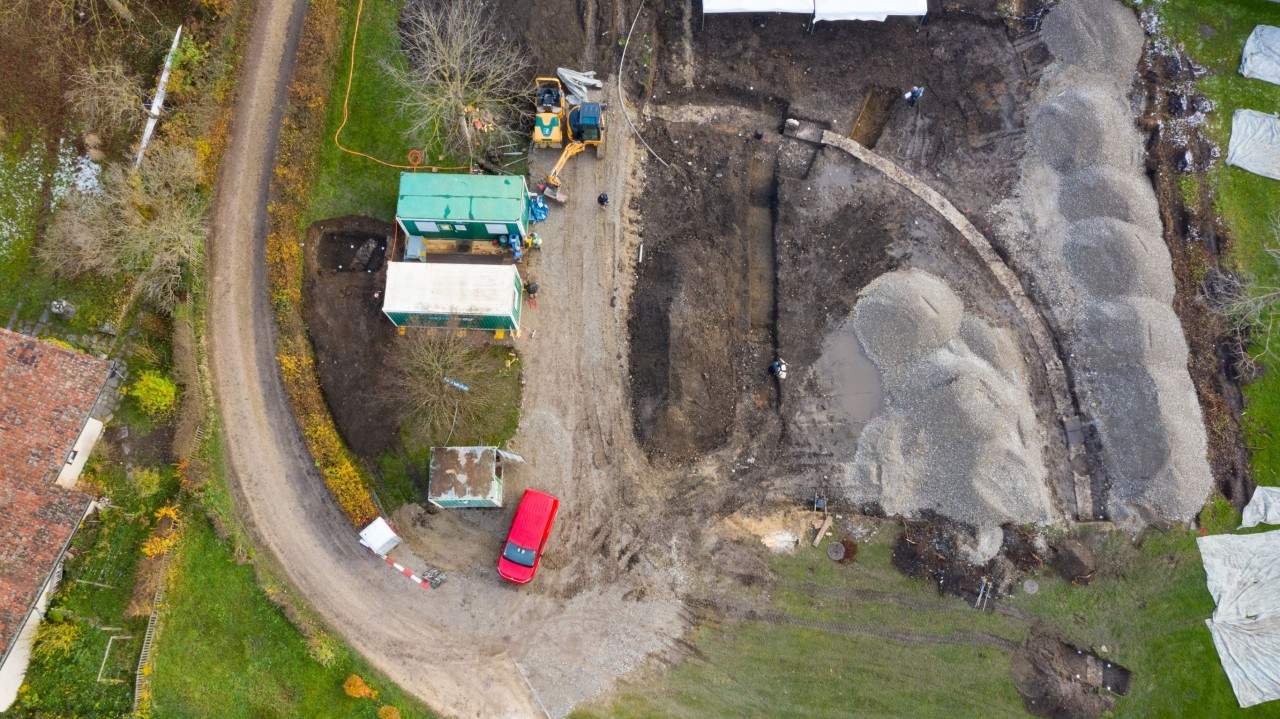Switzerland, large Roman amphitheater discovered near Basel
An important discovery in Switzerland’s canton of Aargau: a Roman amphitheater has in fact been discovered along the banks of the Rhine in the small town of Kaiseraugst, some five thousand inhabitants 20 km from Basel. The remains, uncovered by archaeologists from the canton’s Department of Education, Culture and Sports during construction work for a new boat storage facility for the Basel Rowing Club, belong to a monument that was previously completely unknown. It is the second Roman amphitheater discovered in the canton, as well as the third in the Roman city of Augusta Raurica, today’s Augst, one of the largest Roman settlements in the area as well as the oldest Roman colony on the Rhine known to us, founded in 44 B.C. by Lucius Munazio Planco, Julius Caesar’s lieutenant, in the lands of the Gallic Raurician tribe.
Excavations began in December 2021 and led to the discovery of an oval ring belonging to the amphitheater walls. The function of these walls, unclear at the beginning of the slaves, was uncovered a few weeks ago when it became apparent that the uncovered monument was an amphitheater, about 50 meters long and 40 meters wide, built in a valley immediately west of Kaiseraugst. A portal, flanked on both sides by two side entrances, was also discovered to the south of the complex. The threshold, made of sandstone blocks, of the western side entrance was still preserved. On the west side of the complex was another entrance to the arena, again with a wide sandstone threshold. The interior of the arena wall has been plastered. The grandstands were made of wood (traces of poles were found). All the evidence collected (the oval, entrances, and traces of the placement of a grandstand) was interpreted by cantonment archaeologists as the remains of an amphitheater. Because of the construction materials used, the artifacts and the fact that it was built in an abandoned quarry, dating back to late antiquity, probably to the fourth century A.D., it would be, according to archaeologists from Canton Aargau, the most recently built amphitheater in the entire Roman Empire.
“It was a big surprise for us, and it’s definitely a discovery you don’t make every day, not even in Augusta Raurica,” Kaiseraugst excavation director Jacob Baerlocher said in an interview with the SRF channel. “What personally surprised me the most is that this not-so-small monument (we are talking about an oval with a size of 40 by 50 meters) remained completely unknown and hidden in the ground until December. This made the discovery very surprising. In size it roughly corresponds to the two amphitheaters in the upper city already known. We assume that animal hunts were practiced in such amphitheaters, especially in late antiquity, that is, games in which wild animals were unleashed on each other or exotic animals were killed by hunters.” What makes the discovery particularly important is the dating: the fact that it dates to a late period “makes the discovery extraordinary, because it is a time when no new amphitheaters were actually built. Existing arenas were being renovated, expanded, and in some cases rebuilt. But to see a new one sticking out of the ground is extraordinary, at least in the northwestern provinces, as far as we know.”
“The monument,” reads a Department note, “thus underscores the importance of Castrum Rauracense in the 4th century AD. The fort was an important settlement with a military function on the Roman border, but also an administrative center. The Roman city of Augusta Raurica, the archaeological site of the Roman city of Augusta Raurica, and the late ancient site of Castrum Rauracense form a unity.”
The amphitheater in Kaiseraugst is thus the eighth in Switzerland: the others are those in Windisch (ancient Vindonissa), the other two amphitheaters in Augusta Raurica, and those in Avenches (Aventicum), Martigny (Forum Claudii Vallensium), Nyon (Colonia Iulia Equestris) and the one on the Enge peninsula in Bern (Brenodurum).
“Thanks to close and good cooperation with the client,” says the department, “the construction project could be adapted in such a way as to preserve the Kaiseraugst amphitheater in the ground. The remains are protected by a dam, and above it the new building will rise. The monument will thus remain in its original location and will be optimally protected so that it will be preserved for the future.”
Pictured are the remains of the amphitheater from above.
 |
| Switzerland, large Roman amphitheater discovered near Basel |
Warning: the translation into English of the original Italian article was created using automatic tools. We undertake to review all articles, but we do not guarantee the total absence of inaccuracies in the translation due to the program. You can find the original by clicking on the ITA button. If you find any mistake,please contact us.




























